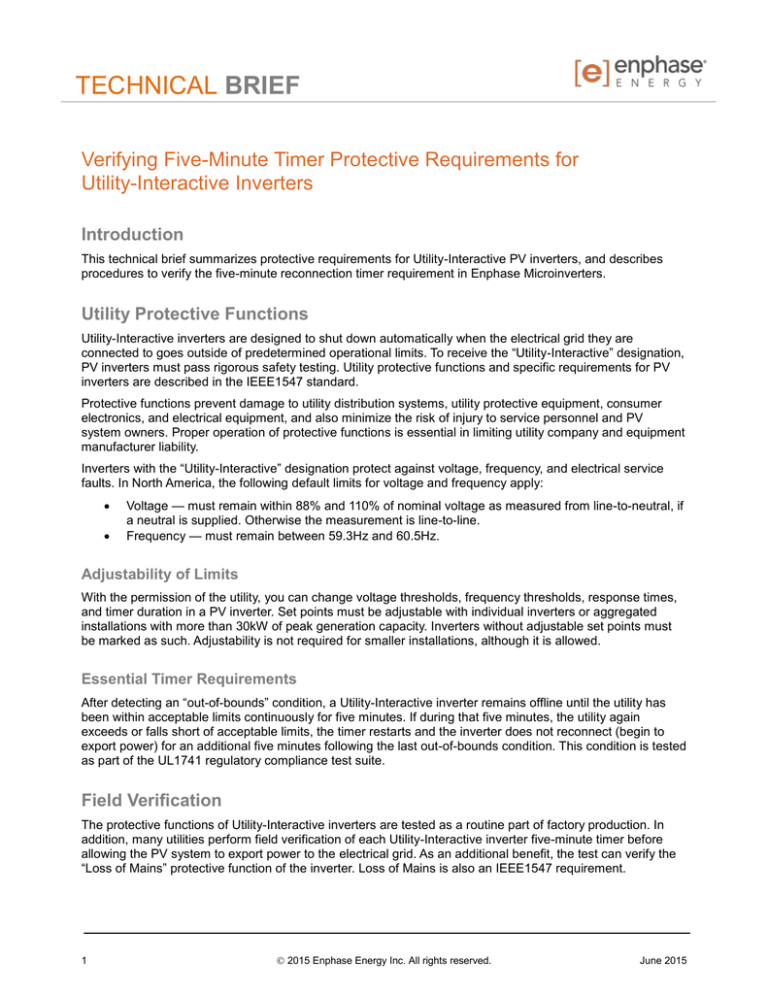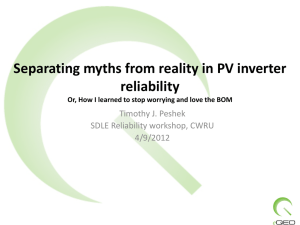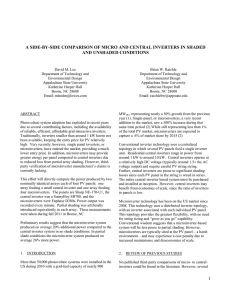
TECHNICAL BRIEF
Verifying Five-Minute Timer Protective Requirements for
Utility-Interactive Inverters
Introduction
This technical brief summarizes protective requirements for Utility-Interactive PV inverters, and describes
procedures to verify the five-minute reconnection timer requirement in Enphase Microinverters.
Utility Protective Functions
Utility-Interactive inverters are designed to shut down automatically when the electrical grid they are
connected to goes outside of predetermined operational limits. To receive the “Utility-Interactive” designation,
PV inverters must pass rigorous safety testing. Utility protective functions and specific requirements for PV
inverters are described in the IEEE1547 standard.
Protective functions prevent damage to utility distribution systems, utility protective equipment, consumer
electronics, and electrical equipment, and also minimize the risk of injury to service personnel and PV
system owners. Proper operation of protective functions is essential in limiting utility company and equipment
manufacturer liability.
Inverters with the “Utility-Interactive” designation protect against voltage, frequency, and electrical service
faults. In North America, the following default limits for voltage and frequency apply:
Voltage — must remain within 88% and 110% of nominal voltage as measured from line-to-neutral, if
a neutral is supplied. Otherwise the measurement is line-to-line.
Frequency — must remain between 59.3Hz and 60.5Hz.
Adjustability of Limits
With the permission of the utility, you can change voltage thresholds, frequency thresholds, response times,
and timer duration in a PV inverter. Set points must be adjustable with individual inverters or aggregated
installations with more than 30kW of peak generation capacity. Inverters without adjustable set points must
be marked as such. Adjustability is not required for smaller installations, although it is allowed.
Essential Timer Requirements
After detecting an “out-of-bounds” condition, a Utility-Interactive inverter remains offline until the utility has
been within acceptable limits continuously for five minutes. If during that five minutes, the utility again
exceeds or falls short of acceptable limits, the timer restarts and the inverter does not reconnect (begin to
export power) for an additional five minutes following the last out-of-bounds condition. This condition is tested
as part of the UL1741 regulatory compliance test suite.
Field Verification
The protective functions of Utility-Interactive inverters are tested as a routine part of factory production. In
addition, many utilities perform field verification of each Utility-Interactive inverter five-minute timer before
allowing the PV system to export power to the electrical grid. As an additional benefit, the test can verify the
“Loss of Mains” protective function of the inverter. Loss of Mains is also an IEEE1547 requirement.
1
2015 Enphase Energy Inc. All rights reserved.
June 2015
Verifying Five-Minute Timer Protective Requirements
Verification Methods
Here are three ways to verify the five-minute timer protective function in an Enphase Microinverter.
1.
Clamp on ammeter
2.
Watch the meter
3.
Power measurement
Details
The following examples assume a typical (U.S.) 240 V split-phase utility service. It is important that the type
of service be determined accurately. The techniques for three-phase measurements are identical. These
examples are specifically for the Enphase Microinverter system. Details vary, but the same principles apply
to any inverter system.
Some inverters draw reactive power when idle. The reactive current may be either leading (capacitive) or
lagging (inductive). From the utility standpoint, a capacitive idle load is almost always preferable.
What Does This Mean?
A PV inverter converts DC power generated by the PV modules into AC power for export to the electrical
grid. PV modules must have direct sunlight to produce power; hence, PV inverters cannot export power at
night. However, a small current can be measured on the branch circuit, even at night. This is the capacitive
VAr current due to EMI filtering components in the inverter.
Capacitive VAr Current in Enphase Microinverters
The following table lists the capacitive VAr current (mA) in an Enphase Microinverter when measured on one
line when no power is produced and a utility grid source is applied. The current value tolerance listed in the
table is +- 20%. The AC current is measured with a clamp-on AC current probe and the accuracy of the
reading also depends on the accuracy of the measurement device.
Enphase Microinverter Capacitive VAr Current in mA*
Service Configuration (North America)
Microinverter
240/120 V single-phase
208Y/120 V
430Y/248 V
Current Arms (mA)
Current Arms (mA)
Current Arms (mA)
M190
67
93
Not applicable
M215
74
104
Not applicable
M250
67
93
Not applicable
C250
Not applicable
Not applicable
77
*Measured on one line when there is no power production and a utility grid source is applied.
Current value tolerance = ± 20%
1. Clamp-On Ammeter
Clamp-on current meters come in several varieties. Some measure both AC and DC current, while others
measure AC current only. In this brief, the term “current probe” includes both measurement types. All but the
least expensive models provide true RMS measurements.
Clamp-on meters include an LCD, and most also measure voltage. Clamp-on probes can provide the same
functionality and are used in conjunction with a standard digital multimeter. Both types of equipment are
manufactured by Fluke, B+K Precision, Ideal, AEMC, Amprobe, and Extech, among others.
2
2015 Enphase Energy Inc. All rights reserved.
June 2015
Verifying Five-Minute Timer Protective Requirements
Procedure
Note: The PV array must be illuminated with direct sunlight; hence, this procedure will not work at night, early
in the morning, or late in the afternoon.
1.
Open the PV system switch or circuit breaker.
2.
Clamp the current probe to one of the phase conductors.
3.
Note the reading (should be zero).
4.
While closing the circuit breaker or switch, note the time or start a stopwatch.
5.
Wait a few seconds and then record the current reading. Refer to the table on page 2 for the
microinverter capacitive reactive current value.
6.
Watch the current reading as five minutes elapses (as noted in step 4). At some point between
five minutes and five-and-one-half minutes after closing the circuit breaker or switch, the current
value should change substantially.
There are a couple of shortcomings with this procedure—a) the measurement does not take power factor
into account, and b) the measurement depends on irradiance—resulting in some ambiguity and the
opportunity for error or misinterpretation of results. Specifically, if the irradiance and array size are such that
the current during power export approximates the reactive current during non-export, it will be difficult to
determine when the system begins exporting power.
There are three possible remedies:
1.
After the five-minutes has elapsed, note the current reading, then cover some portion of the
array and verify that the change in current is proportional to the obscured portion of the array.
2.
Repeat the test when the irradiance is substantially different (either higher or lower).
3.
Use one of the other methods described here.
2. Look at the Meter
This method is extremely simple, requires no test equipment, and is easy to perform. The one drawback is
that absolute accuracy requires all other loads on the premises to be disconnected. The procedure also
relies on the fact that the socketed meter only measures real power. In cases where a dedicated meter is
associated with the PV system, this procedure is extremely reliable.
Procedure
Note: The PV array must be illuminated with direct sunlight; hence, this procedure will not work at night,
early in the morning, or late in the afternoon.
3
1.
Turn off the switch or circuit breaker to the PV system.
2.
Turn off all circuit breakers associated with this meter.
3.
Note the meter reading and caterpillar movement (the caterpillar should not be moving).
4.
While turning on the breaker or switch, note the time or start a stopwatch.
5.
Wait a few seconds and again note the lack of movement of the caterpillar.
6.
Watch the caterpillar as five minutes elapses (from start time noted in step 4). At some point
between five and five-and-one-half minutes from turning on the breaker or switch, the caterpillar
should start showing export of power.
2015 Enphase Energy Inc. All rights reserved.
June 2015
Verifying Five-Minute Timer Protective Requirements
3. Power Measurement Equipment
This is the most deterministic method, requiring the largest investment in capital equipment. It is extremely
accurate and also provides basic verification of system performance.
Procedures will vary depending on the specific piece of test equipment used. Examples of equipment that
can perform this test include:
•
Fluke 1735
•
Fluke 434
•
Fluke 41B
•
Fluke 43B
•
Hioki USA 3169-20 (low cost)
This procedure is substantially simpler than the preceding methods.
Procedure
1.
Open the PV system circuit breaker or disconnect switch.
2.
Connect the power measurement equipment per the manufacturer’s instructions, following all
safety precautions.
3.
Note the readings for Watts and VAr.
4.
While closing the circuit breaker or switch, note the time or start a stopwatch.
5.
Note the readings for Watts and VAr. The Watts will show extremely low consumption (milliwatts
per inverter) and approximately 14 VAr (capacitive, i.e., leading) per inverter.
6.
After five minutes has elapsed, the system will show real power exportation (proportional to
system size and irradiance) and near unity power factor.
Conclusion
Verifying the five-minute utility protective timer is an important step in gaining confidence in the protective
functions of a Utility-Interactive inverter system. You can use one of several methods to verify proper
operation. The method chosen depends on the tester’s initial confidence in the system equipment, availability
of test equipment, and availability of natural sunlight.
You can also verify Loss of Mains functionality using these methods by opening the circuit breaker or
disconnect switch after the system has begun exporting power. It is then a simple matter of confirming that
the system returns to the conditions (Watts and VAr, or current) that existed prior to closing the circuit
breaker or disconnect switch.
4
2015 Enphase Energy Inc. All rights reserved.
June 2015





